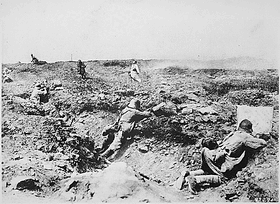The Battle of Memel was a major action fought between the German 1st Army and the Russian 2nd Army during the Baltic War. Memel, very close to the border between Germany and Russia, was one of the keys to victory for the German Empire, as designated by General von Hindenburg. The German 1st Army was ordered to take the city and to prevent the Russians from utilizing the port for the Baltic Fleet, along with the city's industrial sector. The Russian 2nd Army, supported by small elements of the 1st Army to the south, and both under the command of General Kornilov, were to defend the city and to not retreat at all cost. However, Kornilov and other Russian generals planned on deploying the reserves of the further-south 7th and 9th Armies in order to bolster the defenses of the Lithuanian city.
The advance elements of the German 11th Infantry division arrived at the outskirts of Memel on April 6, and met fierce initial resistance from the Russian 9th and 37th divisions, who had constructed earthworks within the suburban streets of the city. The 11th division was then supplanted by additional German divisions, and were able to force the Russian troops into a retreat further east, where the Germans encountered a deep system of fortifications erected by the Russian troops. Both armies fell into a monotonous siege in which men fought hand-to-hand and in very close quarters for the ruins of apartment buildings, stores and government buildings. On April 30, a squadron of warships of the High Seas Fleet arrived, and assisted German troops by way of bombarding Russian positions for the remainder of the battle.
These actions persisted for several weeks more until May 28, when Kornilov, having suffered over 250,000 dead and wounded, and having been constantly bombarded by German artillery and warships, gave the order to withdraw from the city. Hindenburg's troops took complete control of the city on June 1, after annihilating stragglers and looters, and Hindenburg crossed the headlines of German newspapers everywhere, hailed as the Destroyer of the Russian Army. However, the Germans were not without casualties themselves; they had lost 120,000 dead and wounded, and several warships had been damaged by Russian coastal guns. The battle was the first major Russian defeat in the war, although the earlier Battle of Plock can also be regarded as a Russian defeat.

